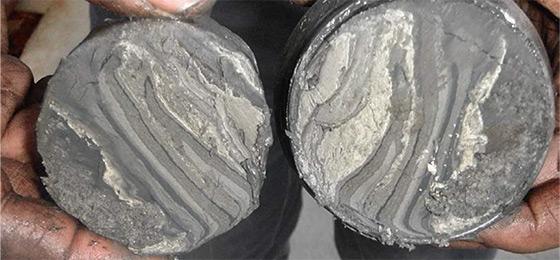Survivors of the Dead Sea

Microbial extremophiles have been found in the highly salty sediment of the Dead Sea. This discovery bears witness to the climatic conditions prevalent there for tens of thousands of years. By Anton Vos
(From "Horizons" no. 107, December 2015)
Imagine being buried alive for 80,000 years beneath 200 metres of very salty sediment. Well, drilling expeditions in Dead Sea deposits have shown that microbes, pretty hard-headed ones at that, can remain very much alive in such conditions. Furthermore, they may shine light on the climatic conditions present when they fell to the bottom of the sea. This research was carried out by the doctoral student Camille Thomas and led by Daniel Ariztegui, a professor at the Earth Sciences Department of the University of Geneva.
"Studying the underground biosphere – the bacteria and archaea [Ed: bacteria-like unicellular organisms without nuclei] living below the earth’s surface – started in the 1990s when we discovered microorganisms living 1.5 km below the seabed", explains Ariztegui. "It was then that we realised the microbes stuck in the sediment represented a huge biomass, possibly as large as all the vegetation on the surface. They play a potentially very important role in the climate and the carbon cycle. We therefore need to improve our understanding of how they are spread throughout the Earth’s crust".
400 metres below the sea
The Dead Sea project was set up under a consortium called the International Continental Scientific Drilling Programme (ICDP). Drilling in the sea – actually a saltwater lake which sits between Jordan, Israel and Palestine – took place in the winter of 2010–11 and resulted in the extraction of a 450-metre core containing 230,000 years’ worth of deposits.
"We used genetic sequencing to detect microbial presence", explains Ariztegui. "It’s above all archaea that live in such conditions of extreme salinity, high pressure and high temperatures. The ones we discovered live in slow motion". A detailed analysis of the samples extracted from the core has convinced Ariztegui that these extremophilic microbes did not migrate into the sediment after it had settled. He thinks that they were trapped there when it formed – and therefore that they are representative of the chemical and physical conditions prevalent in the lake as far back as 80,000 years ago.
In addition, the fact that they are still alive tens of thousands of years later and that they have changed their environment may have a significant impact on the geological archives of lake beds. “These are very important results”, says Gilbert Camoin, Director of the European Consortium for Ocean Research Drilling, the oceanic arm of the ICDP.
A seismic archive
The core of sediment has also allowed for new findings in the field of geological history. Researchers have been able to identify and date samples left by earthquakes that affected the region over the Dead Sea Transform fault system that separates the Arabian and African tectonic plates. Scientists have also been able to establish a stratigraphy of earthquakes and estimate their frequency.
Another spectacular finding of this 450-metre drill was wide variations in the level of the lake, particularly between the cold and wet, glacial periods and hot and dry, interglacial periods. According to these researchers, the Dead Sea was completely dry some 120,000 years ago, but this argument is still very much debated.
Anton Vos is a science journalist, working principally for the University of Geneva.